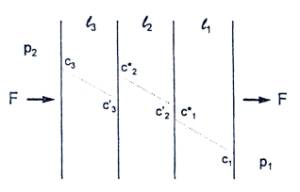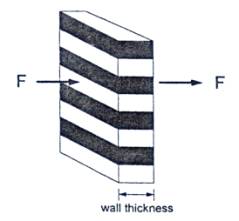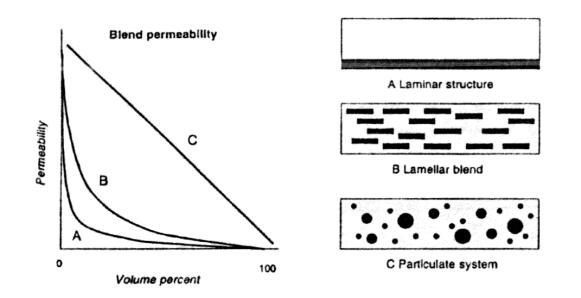Gas Barrier property Testing of Complex Film
For many high barrier property materials, there will be some disadvantages when used individually, such as high price, water sensitive barrier property, inferior transparency and low film mechanical intensity. Although high barrier property material is the main factor for film application development, to replace traditional high barrier property material such as metal and glass, its manufacturing cost must be effectively controlled and the mechanical strength should be improved. When barrier property material is used as one layer of multi-layer complex film, the protection from other layers can effectively improve its applicability and therefore reduce thorough manufacturing cost.
1. Complex Film
Complex film is a kind of multi-layer film, which is made from various kinds of plastics and paper, metal or other materials through technologies such as co-extrusion and molding. The property of complex film such as damp proof, oxygen resistance, fragrant protection, photophobic, mechanical performance, easiness of shaping, seal and print, etc, can be adjusted by changing the type of base material and number of compound layers. Moreover, choosing rational material structure can save material and reduce package cost.
2. Barrier property of Complex Film
Two ways are usually used to improve the gas barrier property of plastic package material.
One is co-extrusion of various materials (materials used as inner layer or outer layer, such as material of layer 1 and 3 in fig.1. these materials have excellent function in improving mechanical strength, heat sealing and friction) with high barrier property material or by coating high barrier property material on the base film to form complex film of multi-layer structure. Complex technologies include dry method complex, extrusion complex, co-extrusion complex, solvent-free complex, coating and vacuum evaporating methods. Generally, Complex film made through these methods can improve material barrier property effectively.
When using this kind of complex film, the orientation of gas transmission is usually vertical to the complex structure of material (see Fig. 1), which can make the material demonstrate more excellent barrier property. Different solubility coefficient S and diffusion coefficient D as well as the complex technology of each layer can exert a certain influence on complex film barrier property, but the overall barrier property is mainly influenced and restricted by the barrier property and thickness of the layer (barrier layer with high barrier property material) that has the best barrier property. Some documents provide formulas for barrier property calculation of complex film. However, since conditions of the material for each layer and overall complex condition are not as ideal as that of the theoretical model, actual parameters of gas barrier property of complex film should be tested with gas barrier property tester. Commonly, barrier property coefficient of complex film, which is mainly determined by the actual thickness of barrier layer and the thickness percentage of this layer, is bigger than that of barrier layer material.

Fig.1 Transmission Through Plane Multi-layer Structure

Fig.2 Transmission Through Parallel Multi-layer Structure
If the orientation of gas transmission is parallel to the complex structure (see fig.2), barrier property obtained in this case is the worst among various complex methods. The formula is:
Φ is the volume percentage of each polymer; however, in the use of complex film, this case is rather rare.
Another way to improve gas barrier property is to mix high barrier property material into the film material. That is, mix two kinds of polymer or add additive into it. Mixing particles of high barrier property material with film material can increase the route of gas transmission, which in turn can increase material barrier property. Shape of filling material, aspect ratio as well as the conglutination between filling material and polymer can all influence gas barrier property. If the conglutination is not good, material barrier property will decrease because there is diffusion through micropores of the conglutinating interface.
The influences of complex and blending on barrier property improvement are different to some extent. In fig. 3, A is the complex method; B and C are blending method. From fig. 3 we can see that through complex method, overall barrier property can be obviously improved using less high barrier property material. However, to achieve similar effect, large amounts of high barrier property material are needed in blending method.

Fig.3 Comparison of Different Blending Methods to Different Gas Barrier Extents
3. Gas Barrier Property Testing of Complex Film
Barrier property testing of complex film is one of the important testing items as well as the main basis in judging whether the structure of complex film is rational and whether there is waste of material, thus, it is an important step in package design and material selection.
Different from the testing of single layer film (including blending material), testing results can be interfered because multi-layer structure of complex film makes its layers discharge or inhale gas. Since content of gas composition of ambient atmosphere is almost the same as that of general atmosphere, specimen edge without seal treatment will become a leaking place of the whole system, which will not only influence data accuracy but also increase the influence of surrounding environment fluctuation on testing. Barrier property testing is a rather sensitive micro testing. This is more obvious in the testing of multi-layer complex film. Please refer to table 1.
Table 1. Testing Fata Comparison
|
Specimen |
A |
B | ||
|
Specimen description |
PE milk film, 105 μ m |
Coextrusion film, 70 μ m | ||
|
Testing condition |
Edge sealing |
Without edge sealing |
Edge sealing |
Without edge sealing |
|
O2GTR |
977.786 |
1268.84 |
1.04 |
1.676 |
|
986.045 |
1208.35 |
1.04 |
1.694 | |
|
999.079 |
1165.64 |
|
1.743 | |
|
O2GTR (mean) |
987.637 |
1214.28 |
1.04 |
1.704 |
|
S |
10.735 |
51.85 |
0 |
0.035 |
|
CV% |
1.087 |
4.270 |
0 |
2.035 |
|
Testing temperature °C |
23 °C |
24 °C |
24 °C |
24 °C |
From table 1 we can see that for multi-layer complex film A and B, whether specimen edge is sealed during testing has a great influence on testing result and data stability. Testing data of Specimen A without sealing treatment increased 23% and the data fluctuation has expanded 3%. For specimen B, the influence is more obvious.
To eliminate the influence of edge leaking on testing result, material edge should be sealed strictly during film barrier property testing. Edge leaking can be reduced to a minimum extent by applying vacuum grease on non-transmission area of lower testing chamber and by adding seal ring on specimen periphery during specimen placement.
Link:http://service.labthink.cn/en/article-Permeation-info-110118111.html
Labthink Copyrights. Please do not copy without permission! Please indicate source when copy.
Relating Articles
- Discussion on Status Quo and Quality Inspection of Edible Oil Package
- Analysis on Purchasing Choice of High Barrier Property Material Testing Instruments
- Suggestions for Barrier Property Testing of High Transmission Rate Materials
- Testing Control Solutions for Candy Packaging Quality
- Labthink Labs & Services -- High&Low Temperature Lab
Member Registration and Login In
| If you are already a member of us, please login in! | If you are not a member of us, please register for free! | ||
·Forget password? |
|
·Terms and Conditions If you have questions, please phone 86-531-85811021 |
|

